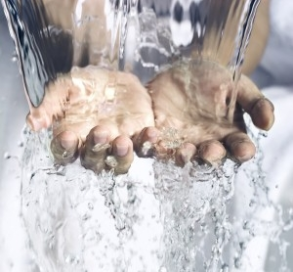 One practice that has become somewhat popular is to remove the water from the font or cover the font completely during the Lenten season. While this may be a dramatic sign of thirsting and dryness, this practice does not in fact support one of the main themes of Lent:
One practice that has become somewhat popular is to remove the water from the font or cover the font completely during the Lenten season. While this may be a dramatic sign of thirsting and dryness, this practice does not in fact support one of the main themes of Lent:
Lent is marked by two themes, the baptismal and the penitential. By recalling or preparing for baptism and by repentance, this season disposes the faithful to celebrate the paschal mystery. The baptismal and penitential aspects of Lent are to be given greater prominence in both the liturgy and liturgical catechesis. Hence, more use is to be made of the baptismal features proper to the Lenten liturgy. (Constitution on the Sacred Liturgy, 109)
If your parish is considering emptying your baptismal font and holy water stoops for the season of Lent, make them stop!
We aren’t fasting from water
The Congregation for Divine Worship (the Vatican committee that oversees all things liturgical) issued a response in 2000 to a request for clarification on this issue. In their response, they say that removing holy water from the fonts during the season of Lent is not permitted, in particular, for two reasons:
- This is an issue of custom, not law, and so the liturgical laws in place do not address this recent innovation. However, this practice “is contrary to a balanced understanding of the season of Lent, which though truly being a season of penance, is also a season rich in the symbolism of water and baptism, constantly evoked in liturgical texts.”
- The fasting of Lent does not include fasting from sacramentals, such as the use of holy water. The response continues: “The practice of the Church has been to empty the Holy Water fonts on the days of the Sacred Triduum in preparation of the blessing of the water at the Easter Vigil, and it corresponds to those days on which the Eucharist is not celebrated (i.e. Good Friday and Holy Saturday).”
In light of CSL’s statement and encouraged by the Congregation for Divine Worship, removing water from the font or preventing the faithful from touching the water in the font would be detrimental to the sign of baptism that is a focus of Lent. The baptized remain a baptized people throughout all of Lent. We do not pretend to be unbaptized as though we were catechumens, just as we do not pretend that Christ is not risen during Holy Thursday or Good Friday. Our Lenten practices should more explicitly emphasize our baptism so that we can recognize those areas in our lives when we are not living out the promises of that baptism. What the faithful should be hungering and thirsting for is not the symbol of their baptism but rather a world in which the faithful living out of that baptism is evident. For the catechumens, their hunger for baptism may even be heightened when there are full fonts of water, just as a person who fasts is more aware of their hunger when food is placed before them.
It would be appropriate, as is our Church’s tradition, to remove the water from the font after the Holy Thursday celebration, keep it empty during Good Friday and Holy Saturday, and fill it with new water at the Easter Vigil. One possible Lenten option is to use a smaller piece of purple fabric that does not fully cover the font but adds some color to the area. In this way, the Lenten color signifies the season while the water in the font is still accessible as a reminder of baptism for the faithful and a sign of God’s promise for the elect.
Image: SCA Svenska Cellulosa Aktiebolaget. Flickr, CC-BY2.0


















Thank you so much for posting this! The Church’s wisdom is a treasure to be admired.
Could you tell me where to find the Congregation for Divine Worship’s 2000 response? I’ve googled but am unable to find this part about water and Lent. If I can find this, I think (hope)our parish will change it’s mind!
P.S. We don’t just dump all the water, we tie up the baptismal font with a big rope… 🙁
Hi Lawson. You can find a copy of the letter here:
http://tinyurl.com/yzal7ws